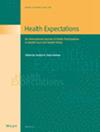Multimodal Analysis of Stories Told by Mental Health Influencers on TikTok
Abstract
Background
Social media influencers are powerful storytellers who function as conduits of public health communication and may contribute significantly to young people's mental health literacy. Influencers who discuss mental health include health professionals, wellness practitioners and experts by lived experience. As yet, there has been no multimodal analysis of how these three influencer types narrate mental health issues. This study critically evaluates 398 TikTok videos to show how three distinct types of influencers construct multimodal narratives around mental health.
Methods
Data was collected using the TikTok Research API and annotated for narrative patterns and visual formatting using an inductively created multimodal framework.
Results
The analysis shows important differences between the storytelling practices of health professionals, who inform others through talking head explainers, enactments and stitches, and lived experience influencers who invited shared perspectives on their stories of illness, treatment and recovery through compilations and ‘watch as I do this’ formats. Wellness practitioners occupy an interdiscursive mid-space, blending the verbal aspects of ‘informing’ (explainers) with the visual narration of ‘shared experience’ to promote solutions through recommendation and advertising. The data also highlights similarities between the health professionals and wellness influencers in their use of marketing calls to action, indicating the commercialisation of mental health solutions offered in TikTok videos.
Conclusions
It is concerning that the gap between information and support provided on TikTok may lead to partial and imbalanced development of mental health literacy by adolescent users and that content provided by certain influencer types mimics authoritative and authentic communication but promotes non-medical solutions to mental health, unsupported by evidence.
Patient or Public Involvement
Twelve young people with lived experience of mental health challenges, aged between 16 and 25, were recruited through The McPin Foundation to form the young people's advisory group (YPAG) for the project. This age range incorporates adolescents and ‘emerging adults’ who are likely to experience a range of life transitions and encounter challenges in mental health. The group met remotely four times during the study, helping to define the categories of influencers, refining the narrative categories and visual formats for the code book and discussing data examples openly to guide the analysis. Two members of the YPAG were trained and participated as coders in the inter-rater reliability process.


 求助内容:
求助内容: 应助结果提醒方式:
应助结果提醒方式:


